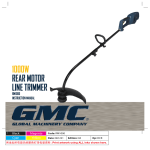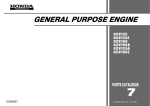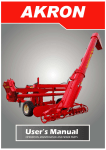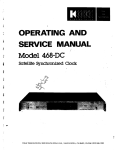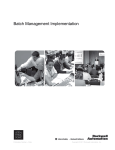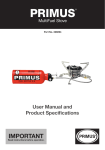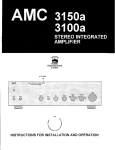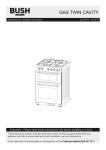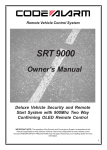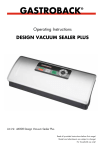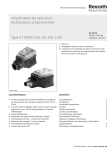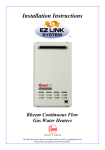Download INSTALLATION, OPERATION AND SERVICE MANUAL GAS COOKER
Transcript
INSTALLATION, OPERATION AND SERVICE MANUAL GAS COOKER MODEL CPG Page 1 / 18 CHAP 1 - INSTRUCTIONS TO PREVENT ACCIDENTS Keep this manual carefully to be able to refer to it in every case of need. • Keep appliance area clean and clear from combustibles. • The place where the machine is to be installed must be enough aerated, this is in order to supply the necessary air for combustion, to prevent reaching too high percentages of gas and to aid evacuation of the products of combustion. • Installation must be conform with local codes, or in absence of it, with the National Fuel Gas Code, ANSI Z 223.1 or with the Natural Gas Installation Code CAN/CGA-B149.1 a) The appliance and its individual shutoff valve must be disconnected from the gas supply piping system during any pressure testing of that system at test pressures in excess of ½ psig (3.45 kPa). b) The appliance must be isolated from the gas supply piping system by closing its individual manual shutoff valve during any pressure testing of that system at test pressures equal to or less than ½ psig (3.45 kPa). • Make certain that the air intake openings in the bottom of the appliance are not obstructed. They are essential for proper combustion and operation of appliance. • Maintain adequate clearance in front of unit for servicing and proper operation. NOTE: All servicing can be done through front door. This equipment is to be installed to comply with the appliance Federal State or local plumbing codes having jurisdiction. THIS APPLIANCE IS EQUIPPED FOR NATURAL GAS, with orifices sized for operation with natural gas. Leave in front view the labels containing the following warnings: WARNING: IMPROPER INSTALLATION, ADJUSTMENT, ALTERATION, SERVICE OR MAINTENANCE CAN CAUSE PROPERTY DAMAGE, INJURY OR DEATH. READ THE INSTALLATION, OPERATING AND MAINTENANCE INSTRUCTIONS THOROUGHLY BEFORE INSTALLING OR SERVICING THIS EQUIPMENT. FOR YOUR SAFETY Do not store or use gasoline or other flammable vapors or liquids in the vicinity of this or any other appliance. WHAT TO DO IF YOU SMELL GAS • Do not try to light applance. • Do not touch any electric switch; do not use any phone in the building. • Immediately call your gas supplier from a neighbor’s phone. Follow the gas supplier’s instructions. Page 2 / 18 • If you cannot reach your gas supplier call the fire department. CHAP 2 - INSTALLATION 2.1 Preliminary instructions Installation must be carried out by following the instructions contained in this handbook and only by a licensed tradesman in accordance with local codes, or in absence of it, with the National Fuel Gas Code, ANSI Z 223.1 or with the Natural Gas Installation Code CAN/CGA-B149.1. The manufacturer cannot be held liable for any damage caused by faulty installation. The place where the machine is to be installed must have aeration equal to at least that given in table 1.1, this is in order to supply the necessary air for combustion, to prevent reaching too high percentages of gas and to aid evacuation of the products of combustion. The installation room must be in conformity with the current fire regulations. The unit must operate in a level position. Slight floor irregularities can be conpensated by turning the adjustable feet of the cooker either clockwise or counterclockwise. Clearances from combustible and noncombustible construction are given in table 1.2 model CPG1 CPG2 CPG3 CPG7/1 CPG7/2 Power (BTU/hr) 60000 (13.2 kW) 120000 (26.4 kW) 180000 (39.6kW) 31000 (9kW) 62000 (18kW) 3 Air flow (m /h) 490 980 1470 315 630 Table 1.1 Minimum change of air in relation to the thermal power installed Clearances Side Rear Floor Ceiling Combustible construction 6.0 ” 6.0 ” 6.0 ” Noncombustible construction 0“ 0“ 0“ 48.0 ” Table 1.2 Clearances from combustible and noncombustible construction 2.2 Handling and Unpacking To move the machine to the place of installation, use a fork-lift truck. Do not drag the appliance on the floor.Take the adhesive protection off the steel surfaces, taking care not to leave any remains of glue, in which case use appropriate thinners to remove them. 2.3 Connecting to the water-main The unit should be connected to your water supply by way of a water faucet. The water pressure should fall between 14.5 and 72.5 PSI. If the water pressure is excessive, a pressure regulator must be installed. The pipe used to discharge the water must be heat resistant and allow for the free flow of the discharge water. A funnel may be used between the unit discharge pipe and the floor drain but tou should never restrict or reduce the diameter of the discharge pipe. The following operations are to be carried out only by specialized technical personnel. Having verified that available water system is adequate you can go ahead and make connection: 1. Clear the pipe of any ferrous waste by letting a certain amount of water flow through. 2. Place the cooker in the desired position and close to the water-main. Page 3 / 18 3. Position the appliance level, adjusting the feet of the cooker. 4. Connect mains pipe to machine pipe (fig.1) using a mechanical filter and an interception cock. 5. Connect machine outlet pipe (fig. 1) to a suitable manifold that withstands high temperatures. 2.4 Connecting to the gas supply mains Before connecting up the gas consult the gas board, all the installation and maintenance operations should be carried out by the gas board or by authorized fitters. Make sure the data of the rating plate correspond to the mains values. The rating plate is located at the bottom of the screen-door panel. Having verified that the gas supply system available is adequate you can go ahead with the connection: 1. connect the mains pipe to the machine pipe (pos. G in fig.1) using a quick closing interception cock which is easy to reach. You must use a pressure regulator to set the manifold pressure as in tab. 4.1 2. Go ahead with setting up and adjusting as described in paragraph 2.4.1 3. Make all the checks listed below. 2.4.1 Setting up and adjusting The first operation to carry out is to check the supply pressure, proceeding as follows: 1. Make sure the gas supply has been cut off. 2. Open the front door, unscrew the closing screw (pos. 9 in fig.6) of the pressure socket of the supply pipe (pos. 1 in fig.6) 3. Connect a pressure gauge to the socket (e.g. a manometer) 4. Open the gas interception cock and measure the value of the supply pressure. 5. CAUTION: If the value of the supply pressure measured lies outside the interval shown in table 2.2, it is not possible to go ahead with installation and it is necessary to inform the gas board of the anomaly with the mains. 6. Close the gas interception cock, disconnect the pressure gauge, screw the closing screw back on and close the front door. Type of gas Supply pressure Inches Water Column (kPa) minimum maximum rated 3.5” (0.87) 10.5” (2.61) 7.0” (1.74) natural gas (methane) G20 Tab. 2.2 Permissible limits for the gas supply pressure After checking the supply pressure it is necessary to adjust the pressure at the nozzle, proceeding as described below: 1. Make sure the gas supply has been cut off. 2. Take off the door by unscrewing the screw fixing it to the support. 3. Remove the water loading knob (1 di fig. 3) and unscrew the two screws fixing the instrument panel to the under-panel. Remove the instrument panel taking care over the wire of the igniter. 4. Open the gas interception cock and ignite the burner flame by following the instructions of par. 5.2 positioning the knob onto the maximum position. 5. Adjuste the pressure regulator since the manifold pressure is 4” W.C. 6. Operate the appliance in the maximum conditions for at least 15 minutes, and then turn the knob onto the minimum position. 7. Turn the minimum adjustment screw (pos. a in fig. 7) to obtain a reduced flame but sufficiently stable and homogeneous. 8. Turn off the burner by following the instructions of par. 5.2, close the gas interception cock, disconnect the pressure gauge, screw the closing screw back on and refit the instrument panel and the front door. 2.4.2 Checks For the purposes of operating safety it is essential to make the following checks: ∗ Checking air-tightness: Check there are no leaks in gas pipe using a solution of soap-water. Page 4 / 18 ∗ Checking operation: Check the burner, the regularity and extinguishing of the flame, following the instructions in this handbook. ∗ Checking the flue gas evacuation system: Make sure there is a functional flue gas evacuation system. CHAP 3 - USER INSTRUCTIONS This manual is an integral part of the product. It is recommended to read the instructions and notices contained in it carefully before starting to use the cooker since it contains essential information on using and servicing the machine safely. This approach is desigated for professional use; All the personnel assigned to using this machine must be trained to use it. CAUTION: THIS UNIT HAS BEEN DESIGNED AND MADE TO BE USED TO COOK OR STEAM WITH WATER ONLY. WHEN IN USE, THE EQUIPMENT SHOULD NOT BE LEFT UNATTEMPTED. The machine should be destined only for the use it has been designed for, every other use is to be considered improper and therefore unreasonable. The manufacturer declines all liability for any damage to persons or things caused by improper, erroneous, or unreasonable use. Any tampering or modification to the appliance that has not previously been authorized by the manufacturer frees the manufacturer from damage deriving from or referable to the above mentioned acts. CHAP 4 - SPECIFICATION MODELS: CPG 1: Gas unit with a single tank of 10.56 gallons. CPG 2: Gas unit with two tanks of 10.56 gallons each. CPG 3: Gas unit with three tanks of 10.56 gallons each. CPG 7/1: Gas unit with a single tanks of 7.4 gallons. CPG 7/2: Gas unit with two tanks of 7.4 gallons each. TECHNICAL DATA Length Width Height Adjustable feet height Weight Tank capacity at maximum level Gas supply mains connection Water mains connection Water outlet connection Rated thermal power Thermal power at minimum Natural gas manifold pressure Primary air adjustment NOZZLE main burner pilot burner minimum screw (bypass) CPG1 CPG2 CPG3 CPG7/1 CPG7/2 35.4” (900 mm) 27.6” (700 mm) 17” (430 mm) 31.5” (800 mm) 47.2” (1200 mm) 15.7” (400 mm) 31.5” (800 mm) 34.4” (875 mm) 115..175 mm 65 Kg 101 Kg 144 Kg 50 Kg 93 Kg 10.6 gal (45 l) 10.6+10.6 gal 10.6+10.6+10.6 gal 7.4 gal (28 l) 7.4+7.4 gal φ ½“ φ ½“ φ 1“ 60000 BTU/hr 120000 BTU/hr 180000 BTU/hr 31000 BTU/hr 62000 BTU/hr 13000 BTU/hr 26000 BTU/hr 39000 BTU/hr 13000 BTU/hr 26000 BTU/hr 4” W.C. FIXED Natural gas G20 diameter (1/100 mm) code diameter (1/100 mm) 335 275 36 110161 36 adjustable adjustable Tab. 4.1 Main technical particulars of the CPG gas cooker Page 5 / 18 CHAP 5 - PUTTING INTO OPERATION 5.1 Operations prior to starting WARNING: if you do not follow these instructions exactly, a fire or explosion may result causing property damage, personal injury or loss of life. Make sure the basin is clean, otherwise clean it as described in paragraph 7.1 If you are using the cooker for the first time, you need to thoroughly clean all the parts that can come into contact with foodstuffs. In this case, proceed as follows: ∗ Fill the basin with water and ordinary detergent. ∗ Put the machine into operation as described in the following paragraph. ∗ When the water is boiling, wait for a few minutes, and then turn off the flame as described in the following paragraph. ∗ Open the door and drain by moving the lever inside into the open position. ∗ Rinse the basin carefully with clean water. With ordinary use, the first thing to do is to load with water: ∗ Close the drain by moving the drain lever onto the closed position. ∗ Turn knob 1 of figure 3 anticlockwise. ∗ Wait for the basin to fill up to the top notch and then close the inlet cock by turning knob 1 of figure 3 clockwise. CAUTION: Do not leave the cooker in operation with no water in the basin. When lighting the pilot follow these instructions exactly: 1. BEFORE LIGHTING smell all around the appliance area for gas. Be sure to smell next to the floor because some gas is heavier then air and will settle on the floor. If you smell gas you must follow the instructions placed in front view of the appliance. 2. Never use tools to push in or turn the gas the gas control knob. If it will not push in or turn by hand , don’t try to repair it, call a qualified service technician. Force or attemped repair may result in a fire or explosion. 3. Don’t use this appliance if any part has been under water, call a qualified service technician to inspect the appliance and to replace any part which has been under water. 5.2 Lighting and shutdown instructions. 1. Carry out the procedures prior to putting the cooker into operation, given in the above paragraph. CAUTION: fill the cooker basin with water up to the top reference notch. 2. Open the gas interception cock, located upstream of the machine. 3. Turn the knob of valve (pos.2 in fig. 3) onto the OFF position and wait 5 minutes to clear out any gas. If you smell gas you must follow the instructions placed in front view of the appliance. 4. Turn the knob of the valve (pos.2 in fig. 3) onto the PILOT position(pos. 1 in fig. 3a). Open the door. 5. Push the knob fully in and hold in, wait few seconds and put a flame near the ignition pipe (see Fig. 5a) until the pilot flame ignites, which may be seen through the slot on the frame. Wait for a few seconds and release the knob. If the flame fails to stay alight, repeat this opration. ATTENTION : you mustn’t put the flame into the pipe, but only near the edge of ignition pipe. 6. Turn knob 2 of figure 3 onto a position between the minimum and maximum ones (2 and 3 of fig. 3a), choosing the optimum value in relation to the quantity of product to be cooked. 7. Close the door and load the basket with the pasta to be cooked. 8. Wait for the water in the basin to boil. 9. Put the full basket into the basin, resting it on the edge and wait for the cooking time to elapse. 10.Remove the basket using the special handles. Page 6 / 18 After cooking, turn off the main burner by turning knob 1 of figure 3 onto position 1 of fig. 3a and turn off the pilot flame by turning it onto the off position (0 of fig. 3a), wait for at least five minutes before draining off the water by moving the lever into the open position and finally proceed with cleaning. CAUTION: Remember to close the gas interception cock. 5.3 Instructions to prevent accidents The personnel assigned to using the electric cooker must keep to the instructions specified in this manual. If the operator has not been sufficiently well trained, operation will not be optimum and the risks concerning safety will increase. it is compulsory to: ∗ ∗ ∗ ∗ ∗ Fill the basin with water up to a level between the two notches. Carry out all the routine maintenance and cleaning operations listed below. Keep the surfaces that can come into contact with foodstuffs clean. Make sure the gas pipes are always sound and well connected. Service the burners periodically, at least once a year. it is forbidden to: ∗ ∗ ∗ ∗ Use the appliance dry. Keep or place inflammable objects by the appliance. Clean the machine using direct jets of water or high-pressure equipment. Put your hands or other parts of your body into the water in the basin while the machine is in operation, or when the cooker is switched off but with the water still hot. ∗ Use objects that are not suitable for contact with foodstuffs to contain the pasta to be cooked. CHAP 6 - TROUBLE SHOOTING CAUTION: For all the operations described below, close the gas interception cock and turn to specialized and authorized personnel who have an adequate knowledge of the functions of the various parts and of the precautions to be taken. Below are listed some possible malfunctioning and the likely cause and remedy, if the problem is not solved or is not contemplated for in the following table, call our customer technical service : MALFUNCTIONING The pilot burner will not ignite LIKELY CAUSE ∗ malfunctioning of the spark plug ∗ insufficient pressure at the pilot burner The pilot burner goes out as soon as the knob is released ∗ The pilot burner does not sufficiently heat the thermocouple ∗ insufficient pressure at the valve The main burner will not ignite even if the pilot burner is ignited ∗ insufficient pressure at the burner REMEDY ∗ Check the spark plug fixing ∗ Check the cable and the connections with the igniter and the spark plug ∗ Check the igniter and the spark plug and replace them if necessary. ∗ Check the supply pressure (§ 2.4.1) ∗ ∗ ∗ Repeat the operation, pressing the valve knob in more fully ∗ Check the relative position of the pilot and of the thermocouple. ∗ ∗ Page 7 / 18 Check the supply pressure (§ 2.4.1) ∗ Check the valve ∗ Check the supply pressure and the pressure at the nozzle (§ 2.4.1) ∗ ∗ ∗ burner holes clogged Check the nozzle and clean it or replace it if necessary. Check the valve Check the valve Check the nozzle and clean or replace it if necessary. Clean the burner. CHAP 7 - CLEANING AND MAINTENANCE Routine maintenance consists of daily cleaning all the parts that can come into contact with foodstuffs and of the periodical maintenance of the burners, nozzles and of the outlet pipes. The instructions to be followed for cleaning are listed below: ∗ Use a soft cloth and neutral detergents. ∗ To clean the stainless steel, do not use steel wool, iron scrapers or brushes since they can deposit ferrous particles that on oxidizing lead to rust. To remove hardened residues, use wooden or plastic spatulas, or stainless steel wool. ∗ If you use alkaline detergents, thoroughly rinse after washing. ∗ Do not spray with direct jets of water or with high-pressure equipment since any water getting into the outer shell can jeopardize the safety of the machine. ∗ Periodically check whether any incrustations have formed in the overflow pipe (due to foam) and clean it if necessary, without using objects that can damage the rubber pipe. ∗ When not being used, do not leave water in the basin. When the appliance is not to be used for lengthy periods, spread a protective film over all the stainless steel surfaces by passing a cloth soaked in Vaseline oil over them, and air the rooms periodically. The periodical annual maintenance of the burners must be done by specialized and authorized personnel and it consists of keeping the holes clean for the fuel-comburent mixture to flow in and out. Access to the burners and nozzles is explained in the following paragraphs. 7.1 Special maintenance The special maintenance procedures should be carried out by qualified and authorized personnel, possibly by means of the technical service of the manufacturer of the component requiring servicing. CAUTION: it is recommended to use only genuine spare parts, in compliance with the same technical specifications as the ones replaced. CAUTION: in any case, before starting, the gas interception cock located upstream of the appliance has to be closed. 7.1.1 Replacing the main burner 1. After making sure you have cut off the gas supply, open the door and unscrew the two screws fixing the burner to the framework. 2. Unscrew the two nuts fastening the valve pipe to the burner (pos. 3 and 4 of fig. 4), and remove the pipe (pos. 1 of fig. 4). 3. Remove the burner and replace it with the new one, taking care to insert the end of the burner into the hole from the other side of the frame. 4. Screw the two screws, for fixing to the frame, back on and fit the pipe connecting the valve to the burner. After these operations it is necessary to check the seal of the gas circuit. 7.1.2 Replacing the pilot burner Page 8 / 18 1. After making sure you have cut off the gas supply, open the door and unscrew the two screws fixing the pilot burner to the framework. 2. Unscrew the nuts fastening the thermocouple, the spark plug and the pipe of the pilot burner (pos.7 of fig.5). Caution, in doing this keep the pilot unit on the inside of the framework, inserting your hand from beneath. 3. Replace the pilot burner and the other defective parts of the assembly. 4. Screw the two screws, for fixing to the framework, back on and fit the pipe, thermocouple and spark plug. After these operations it is necessary to check the seal of the gas circuit and the efficiency of the pilot burner. 7.1.3 Replacing the valve cock 1. After making sure you have cut off the gas supply, remove the door by unscrewing the screw fixing it to the support. 2. Remove the water inlet knob (1 of fig. 3) and unscrew the two screws fixing the instrument panel to the under-panel. Remove the instrument panel. 3. Disconnect from the valve the supply pipe, the pipe that goes to the burner and the one that goes to the pilot burner and the thermocouple (pos. 1,4, 6 and 5 of fig. 6). 4. Disconnect the valve from the under-panel by unscrewing the two screws fixing it and replace it with the new one. 5. Reconnect the gas pipes and the thermocouple in the same positions as before. 6. Refit the instrument panel with the two screws taken out beforehand, fit the water knob onto the relative shaft and fix the front door to the support. After these operations it is necessary to check the seal of the gas circuit, the efficiency of the pilot burner and to repeat the adjustment operations. FIGURES Page 9 / 18 CPG 1 CPG 2 A - water supply connection φ 1/2” B - water outlet connection φ 1” G - gas supply connection φ 1/2” Figure 1 - Overall dimensions and position of the piping CPG 1 – CPG 2 Page 10 / 18 CPG 3 A - water supply connection φ 1/2” B - water outlet connection φ 1” G - gas supply connection φ 1/2” Figure 1 - Overall dimensions and position of the piping CPG 3 Figure 1b - Removable top flue grid assembly Page 11 / 18 CPG 7/1 CPG 7/2 A - water supply connection φ 1/2” B - water outlet connection φ 1” G - gas supply connection φ 1/2” Figure 1 - Overall dimensions and position of the piping CPG 7/1 – CPG 7/2 Page 12 / 18 1. Adjustable foot 7. Flue gas outlet grille 2. Bottom 8. Foam collection grille 3. Right panel 9. Outlet grille 4. Left panel 10.Under-panel 5. Rear panel 11. Front panel 6. Top 12. Water inlet knob Figure 2 - Gas cooker CPG 1 – 2 – 3 – 7/1 - 7/2 components Page 13 / 18 14. Door 15. Magnet 16. Door support plate 18. Door pivot 1 Water supply jet 2 Cock to jet pipe 3 Water inlet cock 4 Water inlet knob 6 Water knob disk 7 Copper pipe from supply to cock Figure 2a – Water supply 1 Rubber overflow pipe 3 Outlet-cock pipe fitting 4 Outlet cock 5 Outlet-rubber pipe fitting 6 Outlet cock lever 7 Copper pipe from cock lever 8 Lever extension Figure 2b – Water outlet Page 14 / 18 1 Double pipe union 3 Outlet-cock pipe fitting 4 Outlet cock 5 Outlet-rubber pipe fitting 6 Outlet cock lever 7 Copper pipe from cock to jet 8 Lever extension 9 Rubber overflow pipe Figure 2b – CPG 2 – CPG 7/2 water outlet 1 - Water inlet knob 2 - Safety valve 3 - Valve reference Figure 3 - Instrument control panel 0 - Closed valve 1 - Open pilot burner 2 - Minimum 3 - Maximum Figure 3a - Valve knob positions Page 15 / 18 1. Main burner 2. Union 3. Nozzle fixing nut 4. Main nozzle Figure 4 - Main burner 1. 3. 4. 5. 6. 7. 8. Pilot burner Gas pipe Thermocouple Spacer Pilot nozzle Fixing nuts Fixing plate Figure 5 – Pilot burner Page 16 / 18 1. 2. 3. 4. Gas supply pipe Brass nut Brass twin-cone Pipe from valve to burner 5. Thermocouple 6. Pilot gas pipe 7. Pilot pipe-valve union 8. Valvle 9. Pressure tube screw 10. Pressure tube washer 11. Fixing washer 12. Fixing nut Figure 6 - Gas supply unit Figure 5a – Manual ignition A. Minimum adjustment screw Figure 7 - Safety valve Page 17 / 18

















